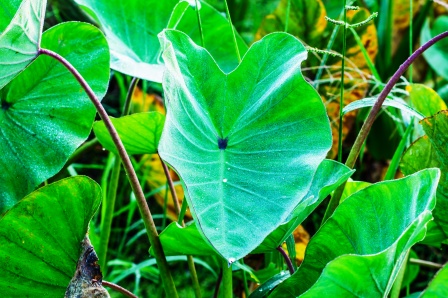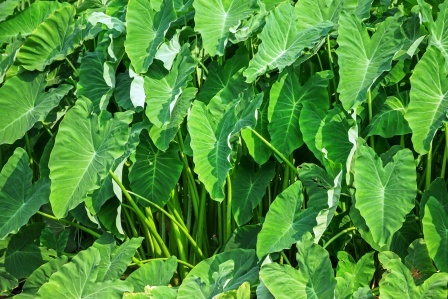Taro Root (Colocasia) – Uses, Recipes, Remedies, Toxicity, Research
By Dr Renita D’Souza
Taro is a tuber crop and is a natural source of energy. It is considered as a good source of carbohydrates and potassium. Traditionally the plant is used as remedy for general debility, constipation, baldness, stomatitis, piles, liver ailments etc. Taro roots and tender leaves are used as vegetables. Juice of leaf stalk is styptic in nature and applied on cut wounds to stop bleeding.
Read – Manakanda Giant taro (Alocasia) Uses, Research, Medicines, Side Effects
Botanical Name – Colocasia esculenta
Synonym – Colocasia antiquorum Schott
Family – Araceae

Table of Contents
Vernacular Names
English Name – Taro, Eddoes, Dasheen, Wild taro, Eddo, Cocoyam, Kalo, Cocoyam
Hindi Name – Arabi, Aruwi, Banda, Ghuyan, Arui, Arvi, Kachalu, Ashukachu
Bengali Name – Kachu, Banakochu, Jongli kochu, Alti Kachu
Marathi Name – Alvacha kanda, Aalu, Chempu, Ran Aalu, Aaloo
Gujarati Name – Alavi
Kannada Name – Kesave, Kesu, Savigadde, Keshavanagadde, Kesavedantu
Tamil Name – Hempu, nir-c-cempu, Peculam, Shemelam
Telugu Name – Chama, Chema, Chammadumpaa
Konkani Name – Terem, Venti
Malayalam Name – Chemp, Manam, Tal, Chembu, Kaattuchembu, Chempakizhanna, Madantha, Seppankizhangu ,Chempu
Tulu Name – Ambuge, Chevu, Kesu, Thevu
Arabic Name – Colcas
Assamese Name – Bon kachu, Pani kachu, Kola Kochu, Kolia Kochu, Kola-kochu
Nepali Name – Aruvee, Gaawaa, Karkalo, Kuchuro, Pindaalu
Odia Name – Kachu, Pechu, Saru
Punjabi Name – Gagli, Gawian, Kachalu
Urdu Name – Aruwi, Ghuyan, Kachalu, Kachchu
Manipuri Name – Pan
Oriya Name – Jongal Saaru (a)
Read – Vidarikand Pueraria tuberosa Uses, Research, Side Effects
Medicinal Qualities
Balakrth – promotes physical strength
Snigdha – unctuous
Guru – heavy to digest
Hrithkaphanashini – reduces the accumulation of kapha in chest region
Vishtambha – causes constipation
The one which is fried with oil is tasty and improves the appetite
Remedies
- Corm of taro is used to cure body ache.
- Juice extract of corm is used to treat alopecia. It acts as an expectorant, stimulant, appetizer and astringent.
- When cooked as vegetable, the mucilage content in vegetable acts as nervine tonic.
- Juice of corm is used to treat baldness.
- Infected Sores – leaf paste is applied as poultice.
- In insect sting, the petiole is cut and rubbed over the affected area to prevent pain and swelling. (d,e)
- Cooked taro roots are used as remedy for liver enlargement (hepatomegaly) and piles.
Read – Onion Uses, Remedies, Research, Side Effects
Taro Leaves
- Rich source of fiber, protein, calcium, iron, magnesium, phosphorus, vitamin A, vitamin C and folate. (c)
- The leaf juice is used in to treat scorpion sting, snake bite, food poisoning from plant origin etc
- As it is a natural source of antioxidants, it improves immunity, neutralizes free radicals that cause cancer and boost overall health by preventing the diseases.
- Due to the Vitamin A content, it is good for maintaining eye health by preventing eye diseases.
- Its natural dietary fiber content helps to maintain the blood cholesterol level and gut health. It slows down the absorption of glucose into the blood stream and thus help to control blood sugar level also.
- Taro leaves are good in anemia due to its iron content.
Read – Surana Elephant Foot Yam Uses, Research, Medicines, Side Effects

Culinary Uses, Recipes
Taro is used as a staple food, snack or as an ingredient in various side dishes.
Taro Recipes
- Chips – Taro root are sliced thin and fried to make chips.
- Spicy curry is made with prawns and taro.
- Badi – Taro leaves and stem are crushed and mixed with de-husked black gram. Then, it is made into small balls and dried.
- Gram flour batter is made and mixed with red chilies and carom seeds. Taro leaves are rolled with this batter and then fried to make dish called Pakora. (read more)
Sanskrit Verses

Nutritional Values
Colocasia esculenta is a good source of starch (70–80 g/100 g dry taro), fiber (0.8%), and ash (1.2%). It is also rich in thiamine, riboflavin, iron, phosphorus, zinc, vitamin B6, vitamin C, niacin, potassium, copper and manganese.
The taro root is rich in fiber, manganese, Vitamin B6, Vitamin E, potassium, copper, Vitamin C, phosphorus, magnesium (f, g)
Toxicity
Due to the presence of calcium oxalate crystals in all parts of the taro plant, consuming raw or under-cooked taro leaves and bulb can be poisonous. This substance is considered toxic when fresh or raw. Calcium oxalate is destroyed by heating. When eaten raw it causes pricking sensation in mouth, tongue and throat.(h)
Read – Carrot (Gajar): Benefits, Remedies, Research, Side Effects
Pharmacological Activity
Colocasia esculenta possesses antimicrobial, antihepatotoxic, anti-diabetic, anti-lipid peroxidative action, anti-metastatic, anti-fungal, anti-inflammatory etc properties.
Phytochemicals
Colocasia esculenta contains beta-carotene, iron, folic acid alkaloids, alkyl-resorcinols, glycosides, phenolics, saponins, sterols, essential oils, resins, numerous sugars and organic acids.
Morphology, Distribution
Morphology
Colocasia esculenta is a tuberous bulb plant growing up to the height of 3 – 5 ft tall.The leaves are large, heart shape resembles elephant ears, triangular ovate, upper surface is dark green and light green beneath.(b)
Distribution
Colocasia esculent Linn. is native to South-east Asia and India.
Read – Dioscorea bulbifera – Air Potato Uses, Research, Side Effects
Research
Antibacterial, Anti-fungal Activity – The study done to evaluate antibacterial and anti-fungal activity of Colocasia esculenta Linn leaves have proved that its ethanolic extract possess potent antibacterial and anti-fungal properties.
Controversy
Colocasia esculenta and Colocasia antiquorum, some botanists consider them both to be members of a single, very variable species. Sometimes Colocasia antiquorum is considered as synonym of Colocasia esculenta.(i,j)
Classification
Classical Classification
Bhavaprakasha Nighantu – Shaka varga
Scientific Classification
Domain – Eukaryota
Kingdom – Plantae
Phylum – Spermatophyta
Subphylum – Angiospermae
Class – Monocotyledonae
Order – Arales
Family – Araceae
Genus – Colocasia
Species – Colocasia esculenta
Click to Consult Dr Renita D’Souza









One comment
BIJAYA KUMAR SAHOO
Really very useful .